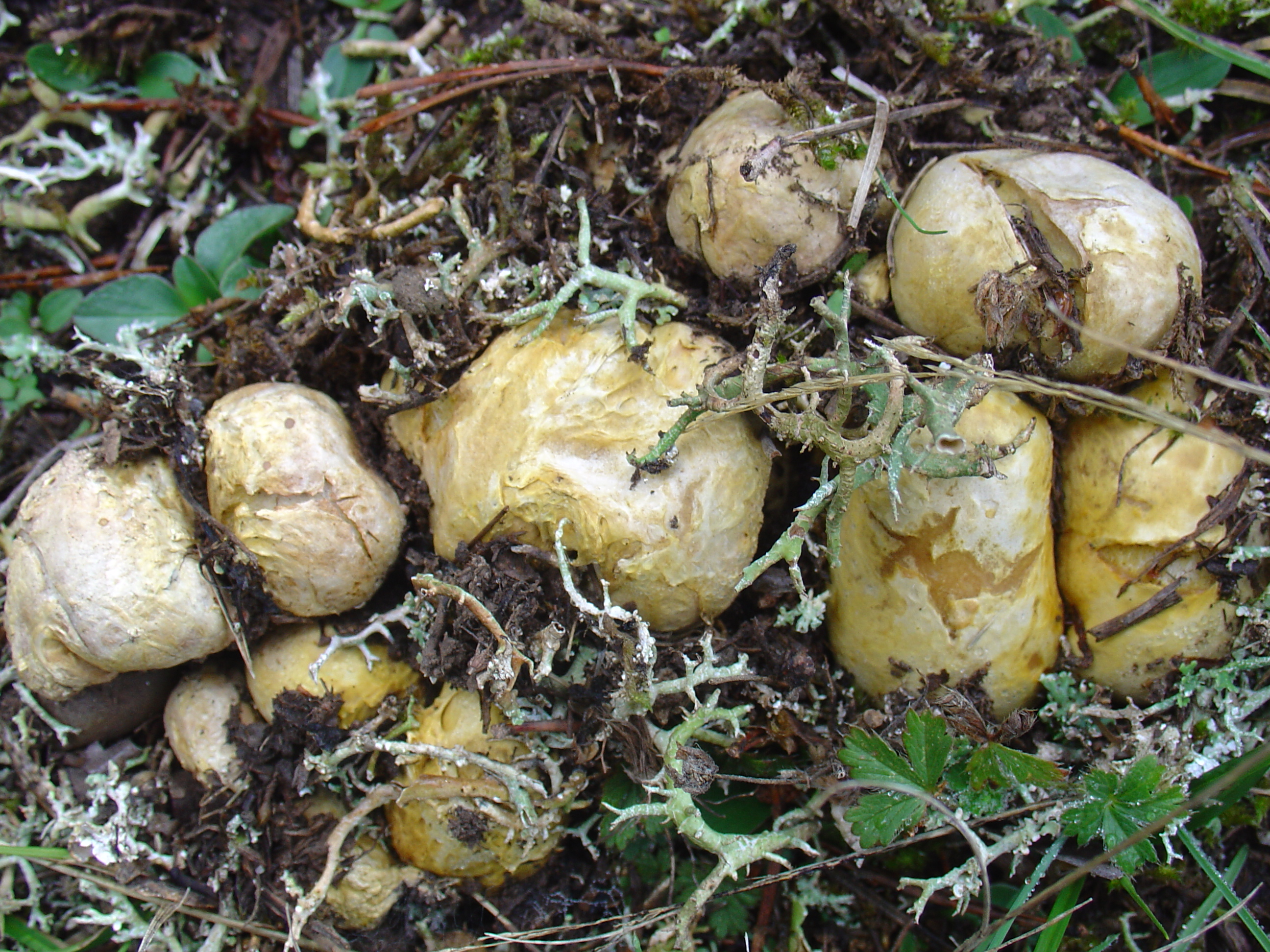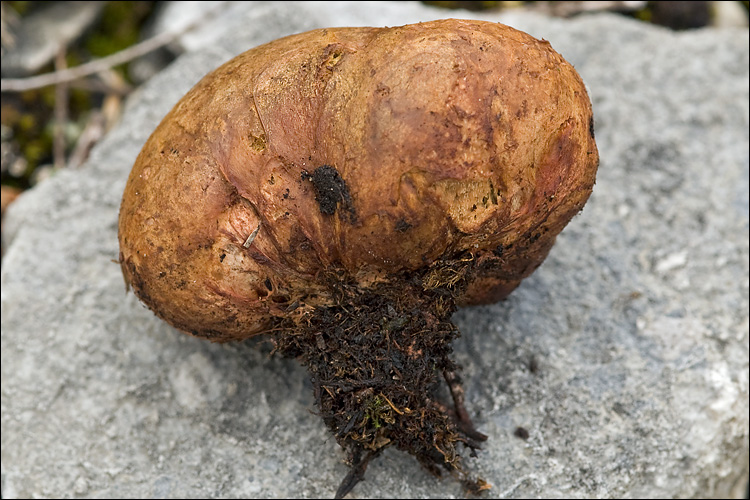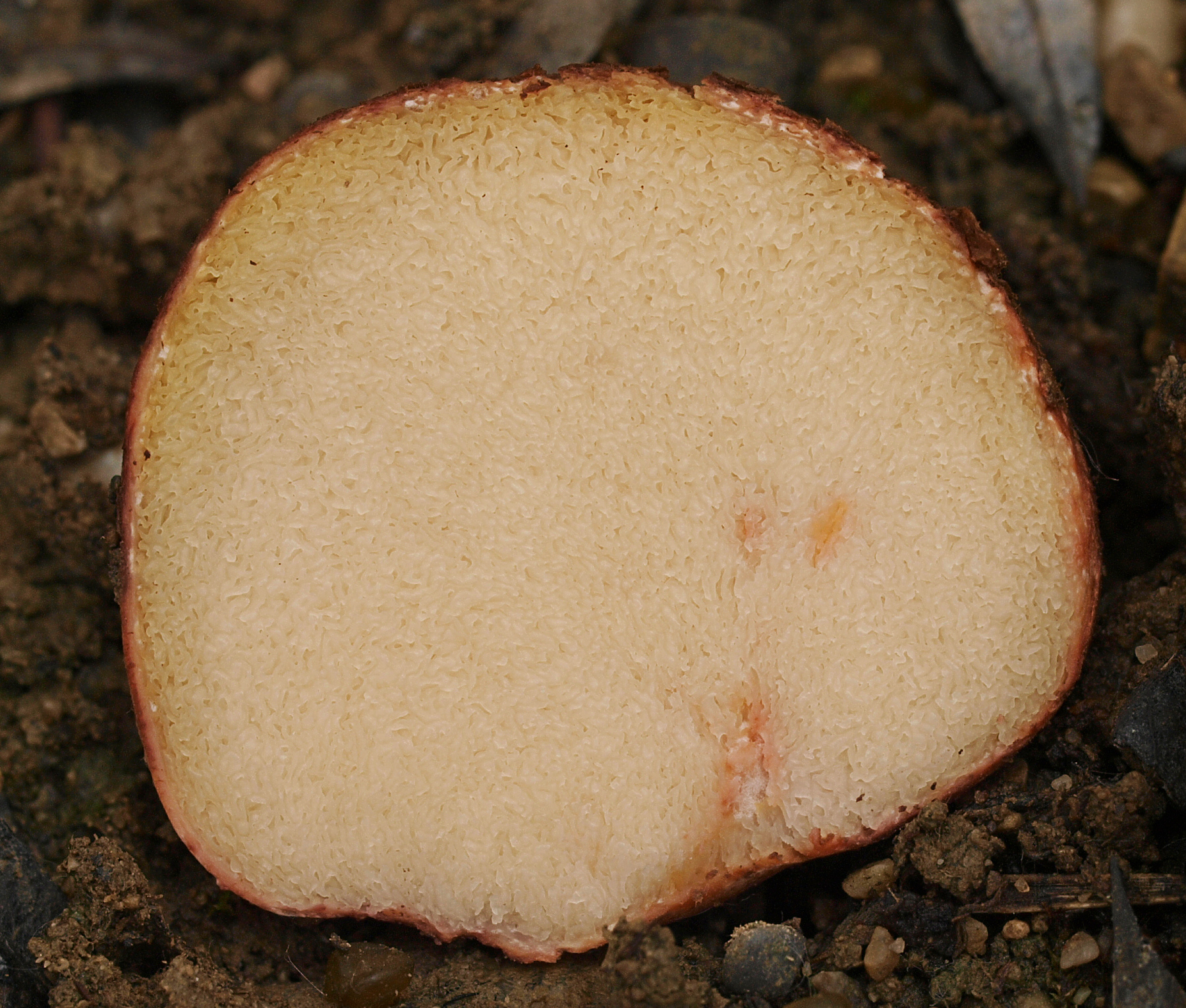|
Rhizopogon Salebrosus
''Rhizopogon salebrosus'' is a mushroom species within the ''Rhizopogon'' sub-genus '' Amylopogon''. ''R.'' ''salebrosus'' is a monotropoid mycorrhiza that is of vital importance to the ecology of conifer forests, especially in the Pacific Northwest region of North America. Although it is native to North America, ''R. salebrosus'' has been found in Europe and its range is generally limited to mountainous regions with sufficient precipitation. The mycoheterotrophic plant, '' Pterospora andromedea'' is often found in an obligate association with ''R. salebrosus'' in western parts of the U.S. Eastern populations of ''P. andromedea'' are typically symbiotic with another ''Rhizopogon'' sub species, ''R. kretzerae''. Species that form these mycoheterotrophic relationships like ''P. andromedea'' and ''R. salebrosus'' benefit one other by sharing essential nutrients. For example, ectomychorrizal plants contribute up to 30% of their fixed carbon in exchange for nitrogen that their host fu ... [...More Info...] [...Related Items...] OR: [Wikipedia] [Google] [Baidu] |
Rhizopogon
''Rhizopogon'' is a genus of ectomycorrhizal basidiomycetes in the family Rhizopogonaceae. Species form hypogeous sporocarps commonly referred to as "false truffles". The general morphological characters of ''Rhizopogon'' sporocarps are a simplex or duplex peridium surrounding a loculate gleba that lacks a columnella. Basidiospores are produced upon basidia that are borne within the fungal hymenium that coats the interior surface of gleba locules. The peridium is often adorned with thick mycelial cords, also known as rhizomorphs, that attach the sporocarp to the surrounding substrate. The scientific name ''Rhizopogon'' is Greek for 'root' (Rhiz-) 'beard' (-pogon) and this name was given in reference to the rhizomorphs found on sporocarps of many species. ''Rhizopogon'' species are primarily found in ectomycorrhizal association with trees in the family Pinaceae and are especially common symbionts of pine, fir, and Douglas fir trees. Through their ectomycorrhizal relationshi ... [...More Info...] [...Related Items...] OR: [Wikipedia] [Google] [Baidu] |
Rhizopogon Amylopogon
Rhizopogon amylopogon is a sub-genus of ''Rhizopogon'' containing seven species. * '' R. brunsii'' * '' R. arctostaphyli'' * '' R. kretzerae'' * '' R. salebrosus'' * '' R. pinyonensis'' * ''R. ellenae'' * '' R. subpurpurascens'' Sub-genus ''Amylopogon'' are ectomycorrhizal fungi categorized as monotropoid mycorrhiza. These fungi are characterized by the presence of a mantle, Hartig net, unique fungal peg, and intracellular hyphal complexes. They are also classified by a specific and obligate symbiosis with members of Monotropoideae through a process known as myco-heterotrophy.Bidartendo MI, Bruns TD (2002) Fine-level mycorrhizal specificity in the Monotropoideae (Ericaceae): specificity for fungal species groups. Mol Ecol 11:557–569 Monotropoideae species depend on ''Amylopogon'' fungi for carbon which they in turn acquire from members of ''Pinus'' in a host specific tripartite Tripartite means composed of or split into three parts, or refers to three parties. Specifically, ... [...More Info...] [...Related Items...] OR: [Wikipedia] [Google] [Baidu] |
Monotropoid Mycorrhiza
A mycorrhiza (from Greek μύκης ', "fungus", and ῥίζα ', "root"; pl. mycorrhizae, mycorrhiza or mycorrhizas) is a symbiotic association between a fungus and a plant. The term mycorrhiza refers to the role of the fungus in the plant's rhizosphere, its root system. Mycorrhizae play important roles in plant nutrition, soil biology, and soil chemistry. In a mycorrhizal association, the fungus colonizes the host plant's root tissues, either intracellularly as in arbuscular mycorrhizal fungi (AMF or AM), or extracellularly as in ectomycorrhizal fungi. The association is sometimes mutualistic. In particular species or in particular circumstances, mycorrhizae may have a parasitic association with host plants. Definition A mycorrhiza is a symbiotic association between a green plant and a fungus. The plant makes organic molecules such as sugars by photosynthesis and supplies them to the fungus, and the fungus supplies to the plant water and mineral nutrients, such as p ... [...More Info...] [...Related Items...] OR: [Wikipedia] [Google] [Baidu] |
Myco-heterotrophy
Myco-heterotrophy (from Ancient Greek, Greek μύκης , "fungus", ἕτερος ', "another", "different" and τροφή ', "nutrition") is a symbiosis, symbiotic relationship between certain kinds of plants and fungi, in which the plant gets all or part of its food from parasitism upon fungi rather than from photosynthesis. A myco-heterotroph is the parasitic plant partner in this relationship. Myco-heterotrophy is considered a kind of Cheating (biology), cheating relationship and myco-heterotrophs are sometimes informally referred to as "mycorrhizal cheaters". This relationship is sometimes referred to as mycotrophy, though this term is also used for plants that engage in Mutualism (biology), mutualistic mycorrhizal relationships. Relationship between myco-heterotrophs and host fungi Full (or obligate) myco-heterotrophy exists when a non-photosynthetic plant (a plant largely lacking in chlorophyll or otherwise lacking a functional photosystem) gets all of its food from the ... [...More Info...] [...Related Items...] OR: [Wikipedia] [Google] [Baidu] |
Pterospora Andromedea
''Pterospora'', commonly known as pinedrops, woodland pinedrops, Albany beechdrops, or giant bird's nest is a North American genus in the subfamily Monotropoideae of the heath family, and includes only the species ''Pterospora andromedea''. It grows as a mycoheterotroph in coniferous or mixed forests. It is widespread across much of Canada as well as the western and northeastern United States to and northern Mexico (Sonora, Coahuila, Durango, Nuevo León and Baja California). Along with '' Monotropa'' it is one of the more frequently encountered genera of the Monotropoideae. The genus name is derived from the morphology of the seeds which have narrow flaps of tissue on the side and therefore appear winged: ''pteron'' (Gr.) = wing, ''spora'' (Gr.) = seed. The specific name ''andromedea'' derives from the resemblance of the flowers to those of another genus in the Ericaceae, '' Andromeda''. The visible portion of ''Pterospora andromedea'' is a fleshy, unbranched, reddish to y ... [...More Info...] [...Related Items...] OR: [Wikipedia] [Google] [Baidu] |
Rhizopogon Re Soil
''Rhizopogon'' is a genus of ectomycorrhizal basidiomycetes in the family Rhizopogonaceae. Species form hypogeous sporocarps commonly referred to as "false truffles". The general morphological characters of ''Rhizopogon'' sporocarps are a simplex or duplex peridium surrounding a loculate gleba that lacks a columnella. Basidiospores are produced upon basidia that are borne within the fungal hymenium that coats the interior surface of gleba locules. The peridium is often adorned with thick mycelial cords, also known as rhizomorphs, that attach the sporocarp to the surrounding substrate. The scientific name ''Rhizopogon'' is Greek for 'root' (Rhiz-) 'beard' (-pogon) and this name was given in reference to the rhizomorphs found on sporocarps of many species. ''Rhizopogon'' species are primarily found in ectomycorrhizal association with trees in the family Pinaceae and are especially common symbionts of pine, fir, and Douglas fir trees. Through their ectomycorrhizal relations ... [...More Info...] [...Related Items...] OR: [Wikipedia] [Google] [Baidu] |
Ericaceae
The Ericaceae are a family of flowering plants, commonly known as the heath or heather family, found most commonly in acidic and infertile growing conditions. The family is large, with c.4250 known species spread across 124 genera, making it the 14th most species-rich family of flowering plants. The many well known and economically important members of the Ericaceae include the cranberry, blueberry, huckleberry, rhododendron (including azaleas), and various common heaths and heathers (''Erica'', ''Cassiope'', ''Daboecia'', and ''Calluna'' for example). Description The Ericaceae contain a morphologically diverse range of taxa, including herbs, dwarf shrubs, shrubs, and trees. Their leaves are usually evergreen, alternate or whorled, simple and without stipules. Their flowers are hermaphrodite and show considerable variability. The petals are often fused (sympetalous) with shapes ranging from narrowly tubular to funnelform or widely urn-shaped. The corollas are usually ra ... [...More Info...] [...Related Items...] OR: [Wikipedia] [Google] [Baidu] |
Orchidaceae
Orchids are plants that belong to the family Orchidaceae (), a diverse and widespread group of flowering plants with blooms that are often colourful and fragrant. Along with the Asteraceae, they are one of the two largest families of flowering plants. The Orchidaceae have about 28,000 currently accepted species, distributed in about 763 genera. (See ''External links'' below). The determination of which family is larger is still under debate, because verified data on the members of such enormous families are continually in flux. Regardless, the number of orchid species is nearly equal to the number of bony fishes, more than twice the number of bird species, and about four times the number of mammal species. The family encompasses about 6–11% of all species of seed plants. The largest genera are ''Bulbophyllum'' (2,000 species), ''Epidendrum'' (1,500 species), ''Dendrobium'' (1,400 species) and ''Pleurothallis'' (1,000 species). It also includes ''Vanilla'' (the genus of the ... [...More Info...] [...Related Items...] OR: [Wikipedia] [Google] [Baidu] |
Spore
In biology, a spore is a unit of sexual or asexual reproduction that may be adapted for dispersal and for survival, often for extended periods of time, in unfavourable conditions. Spores form part of the life cycles of many plants, algae, fungi and protozoa. Bacterial spores are not part of a sexual cycle, but are resistant structures used for survival under unfavourable conditions. Myxozoan spores release amoeboid infectious germs ("amoebulae") into their hosts for parasitic infection, but also reproduce within the hosts through the pairing of two nuclei within the plasmodium, which develops from the amoebula. In plants, spores are usually haploid and unicellular and are produced by meiosis in the sporangium of a diploid sporophyte. Under favourable conditions the spore can develop into a new organism using mitotic division, producing a multicellular gametophyte, which eventually goes on to produce gametes. Two gametes fuse to form a zygote which develops into a new s ... [...More Info...] [...Related Items...] OR: [Wikipedia] [Google] [Baidu] |
Sclerotium
A sclerotium (; (), is a compact mass of hardened fungal mycelium containing food reserves. One role of sclerotia is to survive environmental extremes. In some higher fungi such as ergot, sclerotia become detached and remain dormant until favorable growth conditions return. Sclerotia initially were mistaken for individual organisms and described as separate species until Louis René Tulasne proved in 1853 that sclerotia are only a stage in the life cycle of some fungi. Further investigation showed that this stage appears in many fungi belonging to many diverse groups. Sclerotia are important in the understanding of the life cycle and reproduction of fungi, as a food source, as medicine (for example, ergotamine), and in agricultural blight management. Examples of fungi that form sclerotia are ergot (''Claviceps purpurea''), ''Polyporus tuberaster'', ''Psilocybe mexicana'', ''Sclerotium delphinii'' and many species in Sclerotiniaceae. Although not fungal, the plasmodium of slime ... [...More Info...] [...Related Items...] OR: [Wikipedia] [Google] [Baidu] |
Mycobiont
A lichen ( , ) is a composite organism that arises from algae or cyanobacteria living among filaments of multiple fungi species in a mutualistic relationship.Introduction to Lichens – An Alliance between Kingdoms . University of California Museum of Paleontology. Lichens have properties different from those of their component organisms. They come in many colors, sizes, and forms and are sometimes plant-like, but are not s. They may have tiny, leafless branches (); flat leaf-like structures ( |
Pinaceae
The Pinaceae, or pine family, are conifer trees or shrubs, including many of the well-known conifers of commercial importance such as Cedrus, cedars, firs, Tsuga, hemlocks, larches, pines and spruces. The family is included in the order Pinales, formerly known as Coniferales. Pinaceae are supported as monophyletic by their protein-type sieve cell plastids, pattern of proembryogeny, and lack of bioflavonoids. They are the largest extant conifer family in species diversity, with between 220 and 250 species (depending on Taxonomy (biology), taxonomic opinion) in 11 genera, and the second-largest (after Cupressaceae) in geographical range, found in most of the Northern Hemisphere, with the majority of the species in temperate climates, but ranging from subarctic to tropical. The family often forms the dominant component of Boreal forest, boreal, coastal, and montane forests. One species, ''Pinus merkusii'', grows just south of the equator in Southeast Asia. Major centre of diversity, c ... [...More Info...] [...Related Items...] OR: [Wikipedia] [Google] [Baidu] |








